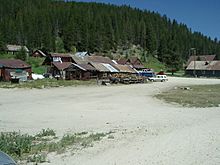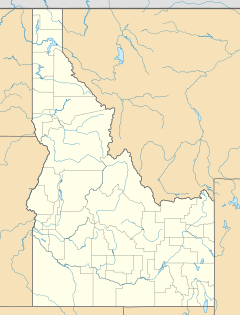Warren, Idaho facts for kids
Quick facts for kids
Warren, Idaho
Warren's Camp, Warren's, Warrens
|
|
|---|---|

Downtown Warren, July 2008
|
|
| Country | United States |
| State | Idaho |
| County | Idaho |
| Elevation | 5,906 ft (1,800 m) |
| Time zone | UTC-7 (Mountain (MST)) |
| • Summer (DST) | UTC-6 (MDT) |
| ZIP code |
83671
|
| Area code(s) | 208, 986 |
Warren is a small, quiet place in the middle of Idaho, a state in the United States. It's not a city with its own government, but rather a community that's part of a larger county. You can find it in a very wild and distant part of Idaho, close to the huge Frank Church River of No Return Wilderness, a protected area of nature.
Contents
Exploring Warren's Location
Warren is located within the Payette National Forest in southern Idaho County. It is northeast of McCall, a popular town. If you were to travel by car, it's about 50 miles away. By air, it's closer, around 30 miles.
This community sits south of the Salmon River. Warren is quite high up, at an elevation of about 5,906 feet (1,800 meters) above sea level. This means it's in a mountainous area.
Warren's Climate and Weather
Warren has a type of weather called a subarctic climate. This means it has very cold, long winters and short, cool summers.
- Winter Months: January and February are usually the coldest. Temperatures can drop very low, sometimes even to -48°F (-44°C)! There's a lot of snow, with over 20 inches falling in both December and January.
- Summer Months: July and August are the warmest, with average high temperatures in the upper 70s°F (around 25°C). However, temperatures can sometimes reach 98°F (37°C) or even 100°F (38°C). Even in summer, nights can be cool, sometimes dropping to the 30s°F (around 2-3°C).
- Rain and Snow: Warren gets a good amount of rain throughout the year, especially in spring and fall. Snowfall is common from November to April.
The History of Warren, Idaho
Warren has a rich history, mostly tied to the search for gold.
Gold Discovery and Early Days
In August 1862, miners who had found gold in other Idaho towns like Pierce and Florence spread out to new areas. They discovered gold in the Warren Creek area. This led to the creation of Warren, making it one of the oldest settlements in what is now Idaho. At that time, it was part of Washington Territory.
During the American Civil War, many people came to Idaho looking for gold. Because of this, the Idaho Territory was officially created in 1863. Soon after gold was found by James Warren from Lewiston, the population of Warren's Camp grew to over 2,000 people! People from the southern states called their part of the camp "Richmond," and those from the northern states called theirs "Washington."
Washington became the main town for Idaho County from 1869 until 1875. In 1875, people voted to move the county seat to Mount Idaho.
Later Years and Mining Changes
After the first gold rush ended around 1875, Warren became known for having a large Chinese population.
The town's population dropped a lot when gold mining slowed down. However, it saw a small comeback in the 1930s when a new way of mining called dredge mining was introduced. During World War II, the U.S. government stopped gold mining in 1942. After the war, people became interested in Warren again, but this time for special metals called rare-earth metals found in a mineral called monazite. Today, a small amount of gold mining still happens in the area.
Wildfires and Modern Warren
Warren has faced threats from forest fires many times. Recent fires in 1989, 2000, and 2007 have affected the area. These fires have also made the Warren area a great spot for finding morel mushrooms, which are popular for eating.
Today, Warren is a very small community with a full-time population of only about 12 to 16 people.
Population Changes Over Time
The number of people living in Warren has changed a lot since it was founded.
- Early Boom: In 1863, there were about 660 people. By 1870, the population was 542.
- Decline: After the gold rush, the population dropped significantly. By 1890, only 113 people lived there.
- Small Comeback: In the 1930s, with new mining methods, the population rose again to 180 in 1930 and 209 in 1940.
- Modern Day: Since the 1950s, the population has been very small, often around 12 to 35 people.



